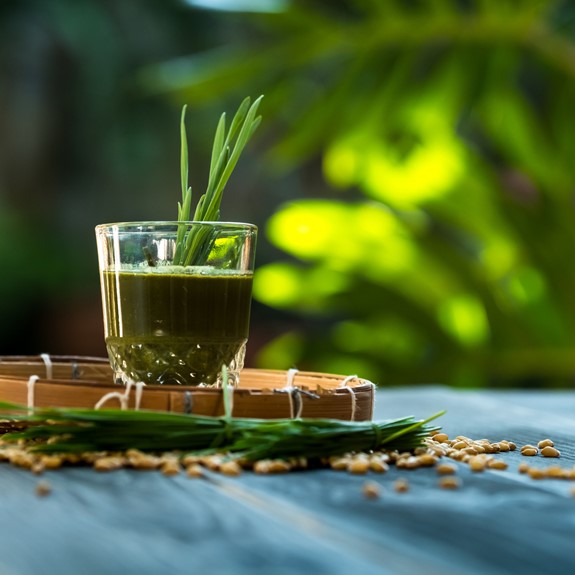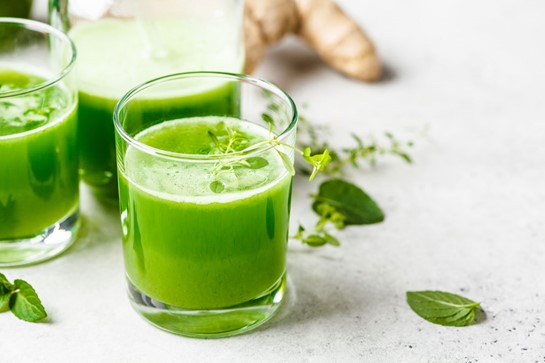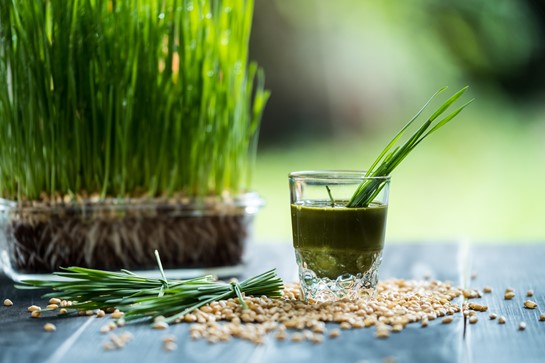
Wheatgrass Juice Benefits
Hippocrates Wellness TripAdvisor Rating
What Is Wheatgrass?
Wheatgrass is the young (gluten-free) grass of the common wheat plant called triticum aestivum. The grass is most commonly grown and harvested at 7-11 days old and juiced into 1-2 oz “shots”.
The juice from freshly pressed wheatgrass is best consumed immediately after extraction and can be ordered fresh for purchase in most juice bars and juicing establishments. Additionally, you can grow it or buy it in grass form and juice it at home yourself.
Wheatgrass can also be ground into a fine nutritious powder, and can be found in tablet, capsule, powder and pill form so if you aren’t able to source the fresh juice or grass, this is a great alternative.
Nutrients in Wheatgrass
Wheatgrass is considered by many people to be the most healing of all grasses. It contains more than 90 elements from the soil, and it is one of nature’s richest sources of vitamins A and C. When it is grown in fertile organic soil, it contains all of the known mineral elements and is ri ch in calcium, magnesium, selenium, phosphorus, iron, potassium, sulfur, sodium, B12, cobalt and zinc. Some health experts claim that wheatgrass contains over 100 nutrients!
Scientists at the University of Texas concluded that wheatgrass juice is exceptional in its chlorophyll content. Known as “nature’s greatest healer,” chlorophyll is ‘bio-chemically similar’ to human blood in nutritional composition and is thought to help build and support a healthy cardiovascular system.
Wheatgrass also helps purify the blood, boost energy and reduce free-radical damage to the heart and body.
This powerful grass creates an internal environment that suppresses bacterial growth and counteracts ingested toxins. It also helps to purify the liver, build the blood’s oxygen-carrying potential and regulate digestion.
As a cocktail, wheatgrass, and the chlorophyll it contains, is a powerful purifier of the stomach, liver, pancreas and circulatory system.
Beyond Chlorophyll, wheatgrass is also rich in amino acids (protein), enzymes which aid in digestion, and a host of vitamins, minerals and natural plant compounds that support optimal health, weight and vitality.
Wheatgrass Contains:
- Chlorophyll
- Selenium
- Zinc
- Potassium
- Magnesium
- Calcium
- B vitamins including B12
- Antioxidants like flavonoids and phenolic acid
- Iron Amino Acids (protein)
- Vitamin A
- Vitamin C
- Vitamin E
Wheatgrass Benefits:
- Supplies a high dose of chlorophyll and nutrients
- Promotes oxygen levels in the body
- Creates an alkaline inner environment in the body
- Boosts metabolism and aids in weight loss
- Natural antibacterial by halting growth of unfriendly bacteria
- Rebuilds and strengthens the blood and cardiovascular system
- Supports healthy hormone balance, removing xeno-estrogens (bad hormones)
- Rebuilds damaged tissue
- Nourishes the adrenal glands and thyroid, helping with sleep, stress and weight management
- Helps detoxify heavy metals and environmental chemicals
- Liver and gall bladder cleanser and purifier
- Helps balance blood sugar by reducing insulin resistance
- Helps disinfect and neutralize odors, infections, wounds, skin grafts, varicose veins and scars
- Helps treat acne, psoriasis, rosacea, eczema and other skin conditions when used internally and externally
- Helps prevent tooth decay and promotes dental health
- Helps break down mucus, alleviating sinus and throat infections Improves digestion and nutrient absorption
- Reduces deficiency
- Calms inflammation and promotes healing
- Helps support healthy eyes and reduces eyesight loss
- Boosts the immune system and healthy bacteria growth in the body
- Improves mental clarity, clearing brain fog and balancing neurotransmitters (happy hormones)
Most Powerful Wellness Benefits of Wheatgrass
1. Supplying High Levels of Oxygen and Nutrients to the Body
The chlorophyll in wheatgrass carries high levels of oxygen (among other things), which is especially powerful in assisting the body to restore abnormalities at a cellular level. The high content of oxygen in chlorophyll helps deliver more oxygen to the blood, nourishing your cells with every heart beat.
Wheatgrass juice can boost red blood cell count, allowing the body to more effectively transport key nutrients to the organs and promoting proper waste removal froam the cells.
Most modern diseases require a low-oxygen environment to exist, and so wheatgrass can be a powerful aid in both chronic-illness prevention and promoting disease reversal. Oxygen is vital to many body processes, especially for the brain which uses 25% of our total oxygen supply.
2. Promoting an Alkaline Body
The human body needs to be alkaline to be healthy! The most common bad habits, environmental pollutants/chemicals, junk and processed foods and poor lifestyle choices are acid- forming while our essential minerals, vitamins and beneficial nutrients provide alkalinity. Wheatgrass promotes a strong alkaline response in the body, helping to counter toxins and support optimal health.
Diseases such as cancer, infection and inflammation flourish in acidic environments, but cease to exist in alkaline ones.
The chlorophyll in wheatgrass, and it’s alkalinity, can help balance our body pH and protect our cells from damage while possessing anti-aging, metabolism-boosting and skin/beauty benefits.
3. Antioxidants and Free radical-protection
Wheatgrass contains strong antioxidant properties that help protect us from disease and oxidative damage. Studies have found that wheatgrass can lower inflammation by inhibiting lipid peroxidation in the liver. Antioxidants support our detoxification organs and can help protect our DNA from mutations that may contribute to cancer development and auto-immune conditions.
Unique antioxidants found in wheatgrass:
- Phenolic compounds
- Flavonoids
- Sulfonic acid
- DPPH (1,1′-diphenyl-2-picrylhydrazyl)
- Triterpenoids
- Anthraquinol
- Alkaloids
- Tannins
- Saponins
4. Loaded with energy and life-force
Wheatgrass juice is the ‘blood’ of the plant and is a source of direct energy. When it is consumed fresh it is a living food and has bio-electricity. This high vibration energy is literally the life force within the living juice. This resource of life-force energy can potentially unleash powerful renewing vibrations and greater connectivity to one’s inner being. These powerful nutrients can also prevent DNA destruction and help protect us from the ongoing effects of pre-mature aging and cellular breakdown. Recent research shows that only living foods and juices can restore the electrical charge between the capillaries and the cell walls which boosts the immune system. When it is fresh, wheatgrass juice is the king of living juices.
You can drink your wheatgrass juice fresh, or add the powder or capsules to smoothies, juices, soups, water or meals.
You can purchase inexpensive wheatgrass seeds and growing/ starter-kits online. There are also numerous affordable juicers/ blenders that can allow you to press your own wheatgrass into liquid form at home, just be sure to always clean your equipment thoroughly to prevent bacterial overgrowth or contamination. It is recommended to find organic quality soil to grow your grass, as the most nutritionally dense wheatgrass is grown in healthy, mineral-rich soil free of pesticides and contaminants.
A little goes a long way with wheatgrass and 1-4 oz of the fresh juice is plenty! If juicing is not your preference, you can always consider a combo green wheatgrass powder mixed with other super-food grasses and vegetables.
Wheatgrass helps promote detoxification and blood purification, and may cause some common (but temporary) initial side effects may include mild nausea, lightheadedness, mild headache, fatigue and the desire to rest. These should pass within an hour of ingestion and will decrease over time, as the body becomes more balanced with fewer toxins.
In order to obtain optimal health, wheatgrass should be taken supplementally, as an addition to a balanced diet and not in place of whole fruits and vegetables.
Wheatgrass is typically consumed raw and so it is advisable to wash your wheatgrass thoroughly, as in rare cases, it may be contaminated with food-borne bacteria or mold. This risk is generally less common when growing your own grown grass. In the case of pregnancy, it is best to consume home-grown wheatgrass juice, or powdered versions only. If you have known allergies to wheat, or other vegetables or grasses, please check in with your Doctor before consuming wheatgrass.
Book a free 30 minute consultation with a Program Specialist
Take the next step and start your journey to better health with Hippocrates today. Discuss how the Hippocrates Life Transformation Mastery Program can support your personal health and lifestyle goals by speaking directly to one of our expert Reservation Specialists.


